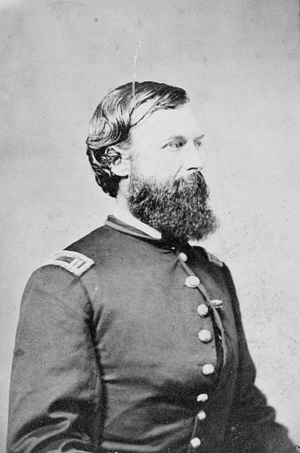Temple Clark facts for kids
Quick facts for kids
Temple Clark
|
|
|---|---|
 |
|
| Member of the Wisconsin Senate from the 19th district |
|
| In office January 5, 1857 – January 3, 1859 |
|
| Preceded by | William J. Gibson |
| Succeeded by | Samuel Thurber |
| Personal details | |
| Born | October 23, 1826 Oneida County, New York, U.S. |
| Died | April 4, 1893 (aged 66) Washington, D.C., U.S. |
| Resting place | Arlington National Cemetery, Arlington, Virginia |
| Political party | Democratic |
| Relatives | Satterlee Clark (brother) Joseph B. Plummer (brother-in-law) |
| Military service | |
| Allegiance | |
| Branch/service | Union Army |
| Years of service | 1847–1848 1861–1863 |
| Rank | Major Gen. (Wis. Militia) |
| Unit | 2nd Reg. Ill. Vol. Infantry 5th Reg. Wis. Vol. Infantry |
| Battles/wars | Mexican–American War
|
Temple Clark (born October 23, 1826 – died April 4, 1893) was an American lawyer and politician. He was a member of the Democratic Party. He also served as an officer in the Union Army during the American Civil War. Clark spent two years in the Wisconsin State Senate. He was also an important helper, called an adjutant, for General William Rosecrans during the war.
Contents
Early Life and Family
Temple Clark was the youngest son of Satterlee Clark, a U.S. Army Major. His father fought in the War of 1812. Major Clark married Frances Whitcroft. Temple Clark was born in New York in 1826.
In 1828, Temple's father and older brother, Satterlee Clark, Jr., moved to Green Bay, Wisconsin. They worked as sutlers for Fort Howard. A sutler was a person who sold supplies to the army. In 1838, when Temple was 12, he and the rest of his family joined them in Wisconsin.
Around 1840, Temple moved to live with his brother at Fort Winnebago. His brother was working there as a clerk. Both brothers left the fort in 1843.
Serving in the Mexican–American War
When the Mexican–American War started in 1846, Temple Clark was living in St. Louis. He joined the 2nd Illinois Volunteer Infantry Regiment. He marched with General John E. Wool's army through Texas and Mexico.
Clark fought in the Battle of Buena Vista. After the war, he returned to Wisconsin in 1847.
Political Career in Wisconsin
After the war, Clark became a lawyer in Berlin, Wisconsin. He later lived for a time in Ceresco, Wisconsin. In 1853, he was made the harbor agent in Manitowoc, Wisconsin. This meant he managed the port.
The government approved money to improve the harbor. Clark helped give out the contracts for this work. By 1856, he was also involved in a road company.
Clark was active in the Democratic Party. In 1856, he was elected to the Wisconsin State Senate. He represented the 19th district, which included Calumet and Manitowoc counties. Before this, these counties had shared a Senate district with a larger county. Clark was the first person from Manitowoc or Calumet to represent the district.
As a Democrat, Clark was part of the minority party in the Senate. His time there was not very eventful. In 1858, he ran for the Wisconsin State Assembly but lost.
Service in the Civil War
In 1858, the Wisconsin Militia was reorganized. Governor Alexander Randall appointed Clark as a Major General for the 8th Division of the Wisconsin Militia. He served in this role until the American Civil War began.
When the war started, Clark was eager to join the Union cause. He immediately began gathering volunteers from Manitowoc County. This group was called the Manitowoc Guard. By May 1861, the company was accepted into Wisconsin's volunteer army.
Clark's company became Company A of the 5th Wisconsin Infantry Regiment. He was made the senior captain of the regiment. The regiment went to Washington, D.C., to serve in the eastern part of the war.
In Washington, the regiment built defenses and guarded areas. In March 1862, they joined General George B. McClellan's Peninsula campaign. Captain Clark left the regiment in April 1862. He was appointed an adjutant, or helper, on the staff of his brother-in-law, Brigadier General Joseph B. Plummer.
Clark joined General Plummer's staff in time for the Siege of Corinth. General Plummer was wounded in battle and later died. After Plummer's death, General William Rosecrans asked Captain Clark to join his staff.
Clark fought with Rosecrans at the Battle of Iuka and the Second Battle of Corinth. He was wounded three times at the Second Battle of Corinth. General Rosecrans praised him for his brave actions. His most serious injury was a gunshot through his lung. Doctors thought he would not survive, but he slowly recovered. However, he had lasting health problems from the wound.
Clark returned to duty in January 1863. He was assigned as an adjutant to General Richard W. Johnson. But he had to leave the army in July 1863 because of his injuries.
Life After the War
After the war, Clark lived in New York City for a while. In the 1870s, he became a detective for the United States Secret Service.
Even though Clark was a Democrat, he supported James A. Garfield in the 1880 presidential election. They had served together on General Rosecrans's staff. After Garfield became president, he gave Clark a job in the United States Department of Agriculture. Clark worked there until he died in 1893.
Temple Clark was buried with military honors at Arlington National Cemetery.
Family Life
Temple Clark was the youngest of five children. His parents were Major Satterlee Clark and Frances Whitcroft. His older brother, Satterlee Clark, Jr., was an important Democratic Party leader in Wisconsin. His sister, Frances, married Joseph B. Plummer, who was one of Temple's commanders in the army.
Temple Clark's grandfather was Isaac Clark. He was an American militia officer during the American Revolutionary War.

